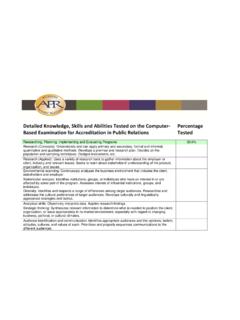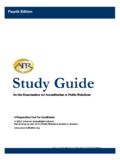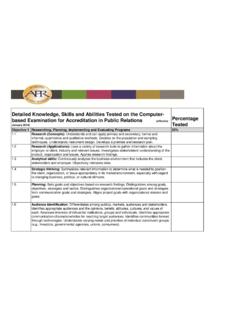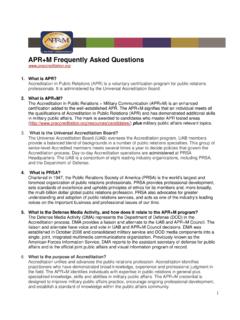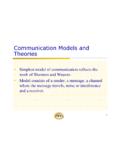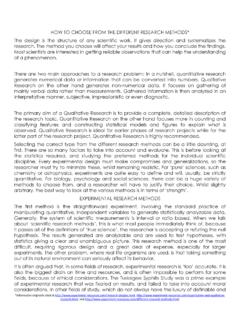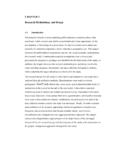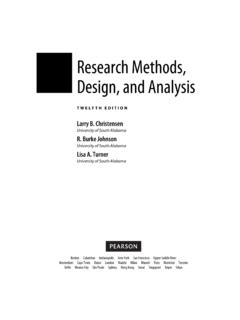Transcription of Research and Research Methods - APR: …
1 Research and Research MethodsWhat we will cover: Formal vs. Informal Qualitative vs. Quantitative Primary vs. Secondary Focus Groups In-Depth Interviews Intercept Interviews1 Research and Research Methods Survey Research Survey Advantages Survey Disadvantages Telephone Survey Mail Survey Online/Email Survey2 Research and Research Methods Population Sampling Confidence Level Types of Samples Non-Probability Samples Determining Random Sample Size Reporting Survey Results3 Research and Research Methods Content Analysis Communications Audit Public Relations Audit Research in the Planning Process Clarifying the Problem Seven Parts to a Research Statement4 Research and Research Methods Identify types of Research Methods , and advantages and disadvantages to these Methods .
2 Be familiar with Research terminology. We are not scientists! 5 Formal Research Formal Research uses the principles of scientific investigation, such as the rules of random sampling in surveys, in order to replicate Research If a sample is used, and it is a true random sample, results can be projected to the larger universe. Example is a phone survey based on random Research Informal Research (or nonscientific Research ) can look at values or qualities; is subjective. Informal Research is good for pre-testing formal Research Findings cannot be projected to represent an entire audience or population. Examples are personal interviews and focus Research Qualitative Research is somewhat subjective. Uses a problem or open-ended, free response format to investigate the value of programs or probe other questions (usually informal).
3 10 Qualitative Research Qualitative Research is descriptive, but not measurable. Looks at how and why. Yields an in-depth understanding of an issue. Example is a focus Research Quantitative Research can be numerically stated or compared; may use statistical standards. Is highly objective and Research Quantitative Research uses closed-end or forced-choice questions. Factual, numerical questions with short responses that have precise and conclusive Research Primary Research is an investigation or the collection of data firsthand, or by a third party contracted specifically for the firsthand party. Research you do yourself that has not been done Research Secondary Research uses the Research findings of others, or collects information secondhand.
4 The examination of Research previously conducted by Groups Informal, primary Research . Advantage: Allows respondents to react to one Groups Disadvantage: High cost; requires multiple sessions; not scientifically valid; subjective information. Do not apply the scientific method and are not statistically -Depth Interviews Informal, primary Research . Advantages: Ability to collect unobtrusive information; best method for highly paid professionals and busy people. Disadvantages: Very expensive; slow to complete; geographic limitations; access Interviews Informal, primary Research . Advantage: Ability to target a geographic location or demographic group. Disadvantage: Limited in length and Research Quantitative method that uses a series of written or oral questions to sample a desired population or universe (group of people).
5 20 Survey Advantages Planned correctly, a survey makes it easy for people to participate. Participants can remain anonymous. Same questions can be asked in several ways to double-check for accuracy and Disadvantages People surveyed may not answer all questions. People who respond may not be part of the universe you intend to sample. It is easy for people to give habitual Disadvantages Low response rate is common. People can and do lie. Can t test knowledge with mailed Surveys (Based on Random Sampling) Formal, primary Research . Advantages: Speed of administration; no geographic limitations; accepted as industry standard. Disadvantages: Requires professional phone bank; cost; limited in length and Survey Formal, primary Research .
6 Advantages: Can use rankings, comparisons; can do message evaluations; convenient for respondent. Disadvantages: Considerable time/labor commitment; limited control over who completes; cost can be high if response rates are Survey Most often informal, primary Research . Advantages: Lower cost of administration; excellent for known populations with access to technology. Disadvantages: Best with known populations; may be difficult to generalize to larger groups or Individuals whose opinions are sought in a survey. The population can be as broad as every adult in the United States or as focused as females who voted in the last election. The sample is drawn to reflect the population; is sometimes called the sample is a portion of a larger whole.
7 How large does the sample need to be? That depends on how accurate you wish to be. Most scientific surveys aim at a margin of error of plus or minus 5 Level Most scientific surveys aim at a reasonable confidence level of 95 percent. If you did the same survey with the same audience 100 times, in 95 of them, the results would be similar to what you got the first of Samples Census A 100 percent sample. Identify all the people in your population and give each one an opportunity to respond. Especially useful with small, well-defined populations. If your universe is under 300, consider a of Samples Probability samples A scientific sample drawn in such a way that the probability of being chosen is equal or is known for example, a random -Probability SamplesInformal selection of persons to be interviewed.
8 Convenience or accidental sample Drop by the cafeteria and ask questions of whoever is there. Quota sample In a school, find 10 elementary teachers, 10 middle school and 10 high school -Probability Samples Dimensional sample Identify a specific number of male or female employees, etc. Any employee is OK as long as he or she fits the criteria. Snowball sample You may know only a few users of a certain product, but they know other users. You contact the first few and ask them for names of others, and so -Probability Samples Purpose sample For opinions of golfers, hang out at the last hole to ask questions. Or for a quick check of music lovers, hang out in the lobby before the symphony Random Sample Size The table on page 63 in the Study Guide shows the effect of sample size on accuracy in a random sample.
9 The illustration is for populations of 100,000 or above, where a random sample of 384 will yield a confidence level of 95 percent with a margin of error of plus or minus 5 Random Sample Size If you wish to reduce the margin of error, you must enlarge the sample substantially. To achieve a plus or minus 4 percent margin, the sample must be nearly doubled to 600. To lower the margin of error by another point to a plus or minus 3 percent, the sample must be more than 1, Random Sample Size Reducing the size of the sample below 384 raises the margin of error and makes the results less dependable. With a sample of 96 or 100 interviews, for instance, the results obtained in the survey could be 10 percentage points above or below the actual level, and could be seriously Survey ResultsDepending on the audience, consider providing the following: Dates when interviews were conducted.
10 Number of interviews and types. Margin of error and confidence level. Number surveys mailed and Analysis The objective, systematic and quantitative description and evaluation of the content of documents, including print media and broadcast Analysis In content analysis, we attempt to objectively code and describe the content of communication. Content analysis involves selecting a unit of analysis, defining categories, sampling and Analysis Most often informal, primary Research . Advantages: Relatively low cost; easy to replicate. Disadvantages: Requires careful definition of units of measurement, units of observation and attributes Analysis Useful to compare messages that appear in the media, such as TV vs.
